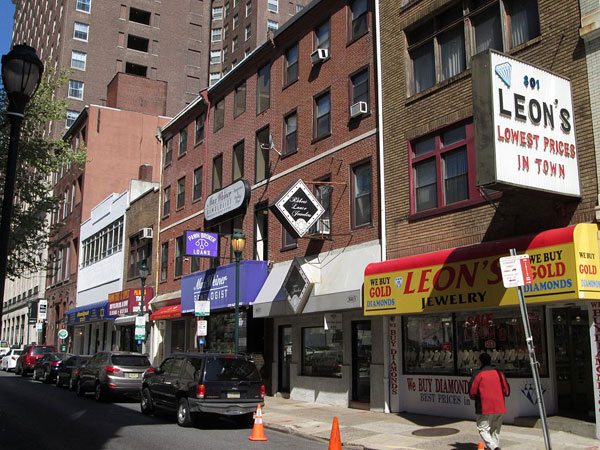
December 26, 2017; Next City
Philadelphia, the birthplace of the Declaration of Independence and the US Constitution, has a lot of old buildings. According to local public radio station WHYY, Philadelphia has more buildings erected before 1945 than any other US city except for New York.
Nonetheless, historic preservation has lagged. WHYY observes that, “2.2 percent are locally designated as historic, compared to the 50-city average of 4.3 percent, while 4.2 percent of Philly’s buildings are listed in the National Register of Historic Places, compared to a 6.8 percent average.” (The first designation refers to stronger local protections, the second to eligibility for federal tax credits.)
The reason why fewer structures are protected in Philadelphia is not so mysterious, however. As Jared Brey points out in Next City, “in a city that for decades has been desperate for development of any kind,” the perceived need to protect existing structures was low.
Now that is changing, even if the context is complicated. On the one hand, after a half-century of decline—the city’s population fell by more than half a million between 1950 and 2000—Philadelphia is now growing, adding 79,000 residents in the past decade. Development is booming. and buildings that everyone assumed were sacrosanct (but lacked formal protection) are now at risk. On the other hand, Philadelphia still has, at 25.7 percent, the highest poverty rate of the nation’s ten most populous cities by far. (Houston, at 20.8 percent, is a distant second.)
These trends help set the stage for a conflict between the values of historic preservation and equity. According to Brey, a developer’s proposal to demolish six buildings on “Jewelers’ Row, a block of 18th- and 19th-century buildings, six blocks east of City Hall, that make up the oldest diamond district in the United States,” led Philadelphia Mayor Jim Kinney to appoint a Historic Preservation Task Force. In a city where people of color constitute roughly 65 percent of residents, creating a city task force where 24 of 29 members were white did not go over well. Last July, WURD radio talk show host Charles Ellison wrote:
The Task Force presents us with yet another white-male heavy cookie cutter approach to urban planning. In a city that’s nearly half black (and 15 percent [Latinx]), it defies logic that the city didn’t think to increase African American participation on the panel beyond a measly 6 percent. It can’t be that the city is 35 percent white and yet the latest effort leading Philly’s new urban renaissance is about 83 percent white.
The task force did respond, notes Brey, “by adding several people of color, some of whom were listed as ‘community representatives.’” The challenge, of course, is not just about committee composition, but also, critically, whose communities are preserved and who pays the bill.
Sign up for our free newsletters
Subscribe to NPQ's newsletters to have our top stories delivered directly to your inbox.
By signing up, you agree to our privacy policy and terms of use, and to receive messages from NPQ and our partners.
Harris Steinberg, a Drexel University urban planning professor who chairs the Task Force, acknowledges that “preservation up until now has been seen by many as an elitist, educated, largely Caucasian profession.” Steinberg says he hopes that out of the Task Force, Philadelphia can begin to develop a “broader definition of preservation.”
Brey highlights Christian Street Baptist Church in South Philadelphia as a microcosm of the issues at play. The Church, originally a “Protestant Episcopal mission for Italian immigrants…has been a landmark in the Bella Vista neighborhood since the 1890s. African-American Baptist congregations mainly have been the occupants since the early part of the 20th century.” The Church is a relevant example, as a Pew report this fall identified 839 historic churches in the city.
With Christian Street Baptist, the largely Black congregation had lost members, while the neighborhood had gentrified. The Church also had “structural issues and a mold problem.” The congregation decided to sell. “In a matter of hours,” Brey writes, “a Philadelphia developer who planned to tear down the church and build townhomes offered just below the asking price of around $1.5 million, and the congregation accepted.” At that point, a city historic preservation advocate intervened, nominated the church for historic protection, and disrupted the sale.
Brey underscores that,
It’s not just churches that are under threat. The rejuvenation of Philadelphia’s real estate market has been accompanied by the destruction of iconic theaters, beloved diners, public schools, landmark hospitals and hundreds of run-of-the-mill rowhomes that, taken together, make up the essential urban fabric of the city.
Last-minute applications filed for preservation as a wrecking ball swings toward a building, however, aren’t a sustainable long-term plan. Neither are methods that end up pitting advocates…against a church congregation struggling to maintain a property.
The task force aims to issue a white paper on the state of preservation by the end of January. Brey adds, “The task force will then spend six months developing recommendations for how the city can update its regulations, or create incentives, for how to complete a survey of historic properties and improve education about historic properties.”—Steve Dubb













